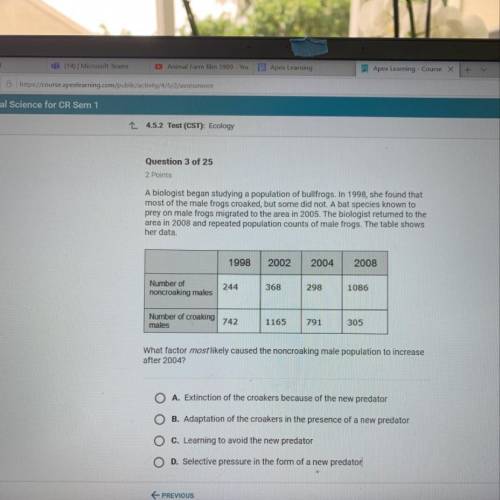2 Points
A biologist began studying a population of bullfrogs. In 1998, she found that
m...

Social Studies, 05.05.2020 08:02 sylviaangelinn
2 Points
A biologist began studying a population of bullfrogs. In 1998, she found that
most of the male frogs croaked, but some did not. A bat species known to
prey on male frogs migrated to the area in 2005. The biologist returned to the
area in 2008 and repeated population counts of male frogs. The table shows
her data
1998
2002
2004
2008
Number of
noncroaking males
244
368
298
1086
Number of croaking 742
males
1165
791
305
What factor most likely caused the noncroaking male population to increase
after 2004?
O
A. Extinction of the croakers because of the new predator
O
B. Adaptation of the croakers in the presence of a new predator
O
c. Learning to avoid the new predator
O
D. Selective pressure in the form of a new predator
HELP HELP PLEASE!!


Answers: 3


Another question on Social Studies

Social Studies, 22.06.2019 03:30
Which theoretical perspective would lead you to consider the broader social effects of the division of labor between men and women in the household? symbolic interactionism queer theory conflict theory structural functionalism
Answers: 1

Social Studies, 22.06.2019 11:30
What does this quotation say about how miranda’s confession was made?
Answers: 1

Social Studies, 22.06.2019 17:30
Which type of learning occurs when you observe how other people act?
Answers: 2

Social Studies, 23.06.2019 05:30
How is germany's location in europe an advantage during wwii?
Answers: 1
You know the right answer?
Questions

Mathematics, 05.11.2020 22:10

History, 05.11.2020 22:10



Arts, 05.11.2020 22:20

English, 05.11.2020 22:20






Business, 05.11.2020 22:20

Mathematics, 05.11.2020 22:20

World Languages, 05.11.2020 22:20

Mathematics, 05.11.2020 22:20

Mathematics, 05.11.2020 22:20


Computers and Technology, 05.11.2020 22:20




